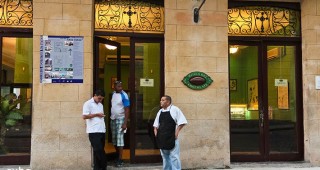
The International collection (Edificio de Arte Internacional)
In 2001, after the new venues were chosen for the National Museum of Fine Arts, the international collection was installed in the former Centro Asturiano, a magnificent edifice built in Spanish Renaissance style in 1927. For its construction, 1,250 tons of marble from Italy, Spain and the United States were used, and Cuban cedar and mahogany for the woodwork. The stained-glass ceiling over the stairwell and the cast-bronze and Bohemian glass lamps were made in Spain.
The museum features and art collection divided into eight curatorial sections. It includes works from France, Spain, Italy, Holland, Great Britain, Asia, the United States, Flanders, Latin America and Germany. There is also an ancient art collection that includes Greek, Roman and Egyptian sculptures and artifacts donated to the museum by Dr. Joaquín Gumá Herrera, Count of Lagunillas. Also notable is the collection of Spanish Art, with over 700 pieces by the most important Spanish painters of the 19th century, including Sorolla, Lucas Velázquez, Mariano Fortuny, Raimundo de Madrazo and Zuloaga. There are also works by several English portrait painters, among them Kneller, Reynolds and Gainsborough.
One mid—eighteenth century day in London, the Venetian painter Canaletto found himself a bit strapped for cash and decided that drastic measures had to be taken. Whipping out a handy blade, he sliced in half a rather long landscape he’d painted, to sell both halves separately. Now one half of Chelsea from the Thames hangs in Blickling Hall in Norfolk. The other half is in Havana in the Museo de Bellas Artes
Arte Universal is breathtaking for the breadth of the collection and the extraordinary building in which it is housed. One—upmanship amongst rich representatives of the various Spanish provinces was the order of the day in nineteenth and early twentieth century Havana. Bellas Artes’ International collection is hung on what used to be the Centro Asturiano, a towering neoclassical edifice overlooking Parque Central and the Gran Teatro de La Habana, which was in its turn developed and embellished by the Galician Club. One imagines the Asturianos and the Gallegos glowering at each other across the square as they plotted their next socially competitive move. The monumental effect of the Arte Universal facade was dramatically complemented and highlighted last year by the placing in front of it of Louise Bourgeois’s traffic—stopping spiders, probably the most successful and remarked—upon public art seen in Havana since the installation of the Fountain of the Indian aka Noble Habana.
Once you’ve stopped gasping at the staggering staircase swooping up from the central atrium of Arte Universal, have a good look round. Particularly recommended are the English and Italian galleries; in the latter hangs perhaps our favourite painting in the entire collection: a fabulous swagger portrait of the Marquesa de Pinar del Río in a drop—waisted flapper dress, with a huge fan and an even huger sense of style. And in the former, glowing gloriously yet somewhat incongruously in its Habanero setting, is Canaletto’s depiction of Chelsea Hospital. Sadly the two halves of the painting cannot be exhibited together abroad, as an American foundation has declared its intention of pouncing on the Cuban part if it ever leaves the island. It is to be hoped that in this, as in so many other areas of Cuban—American relations, a sensible, creative and above all an un—hysterical resolution may one day be reached.
Admission details: Individual buildings: CUC 5; both: CUC 8. Free under-14s
Opening hours: 10am-6pm Tues-Sat; 10am-2pm Sun








 Modern
Modern








